Hassani S. Mathematical Physics: A Modern Introduction to Its Foundations
Подождите немного. Документ загружается.

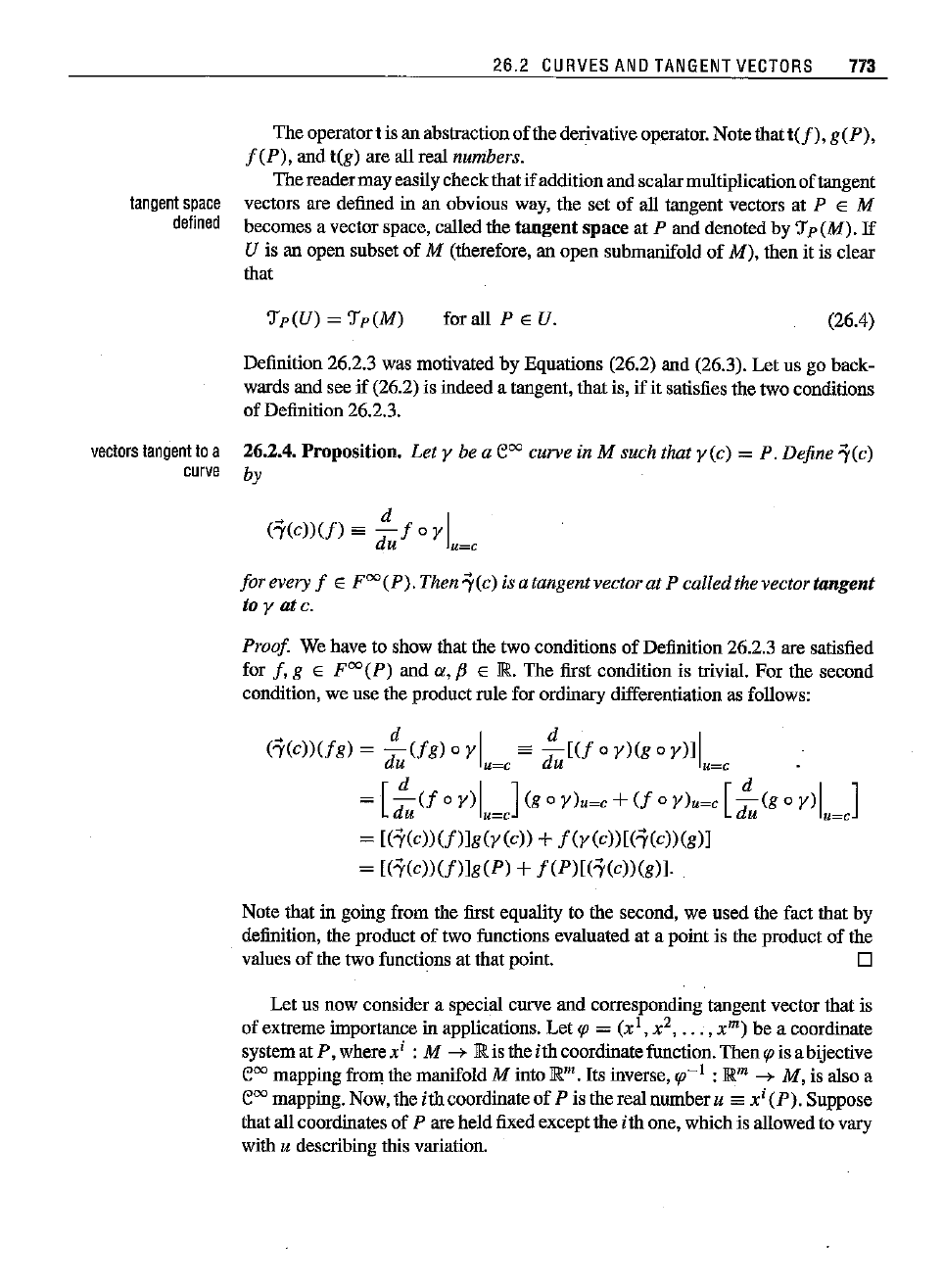
26.2
CURVES
AND
TANGENT
VECTORS
773
The operator!is an abstraction
of
the derivative operator. Note
thatt(f),
g
(P),
f(P),
and t(g) are all real numbers.
The reader may easily check that ifadditionand scalar multiplicationoftangent
tangent
space
vectors are defined in an obvious way, the set of all tangent vectors at P E M
defined
becomes a vector space, called the
tangent
space
at P and denoted by 'Jp
(M).
If
U is an open subset
of
M (therefore, an open submanifold
of
M),
then it is clear
that
'Jp(U)
=
'Jp(M)
foraliPEU.
(26.4)
Definition 26.2.3 was motivated by Equations (26.2) and (26.3).
Let
us go back-
wards and see
if
(26.2) is indeed a tangent, that is, if it satisfies the two conditions
of Definition 26.2.3.
vectors
tangentto a 26.2.4. Proposition.
Let
y be a e
oo
curve in M such that
y(c)
= P. Define ;Y(c)
curve
by
~
d I
(J(c))(f)
sa du f 0 Y
u~c
for every f E
FOO(P).
Then;Y(c) is a tangentvectorat P calledthe vector tangent
to y
ate.
Proof
We have to show that the two conditions of Definition 26.2.3 are satisfied
for f, g E
FOO(P)
and 01,
fJ
E R The first condition is trivial. For the second
condition, we use the product rule for ordinary differentiation as follows:
~
did
I
(J(c))(fg)
= du
(fg)
0 Y
u~c
;;: du
[(f
0
y)(g
0 y)]
u~c
=
[:u
(f
0
y)luJ
(g 0
Y)u~c
+
(f
0
Y)u~c
[:u
(g 0
y)luJ
=
[(;y(c»(f)]g(y(c))
+f(y(c))[(;Y(c))(g)]
=
[(;Y(c»(f)]g(P)
+f(P)[(;Y(c))(g)].
Note that in going from the first equality to the second, we used the fact that by
definition, the product
of
two functions evaluated at a point is the product of the
values of the two functions at that point. D
Let us now consider a special curve and corresponding tangent vector that is
of extreme importance in applications.
Let
<p
=
(r
',
x
2
,
••.
,
x'")
be a coordinate
system at
P,
where xi : M
--+
Ris the
ith
coordinatefunction. Then
<p
is abijective
e
oo
mapping from the manifold
Minto
R
m.
Its inverse, <p-l : Rm
--+
M,
is also a
e
oo
mapping. Now,the
ith
coordinate
of
Pis
therealnnmberu
sa
xi(P).
Suppose
that all coordinates of
P are held fixed exceptthe
ith
one, which is allowed to vary
with u describing this variation.
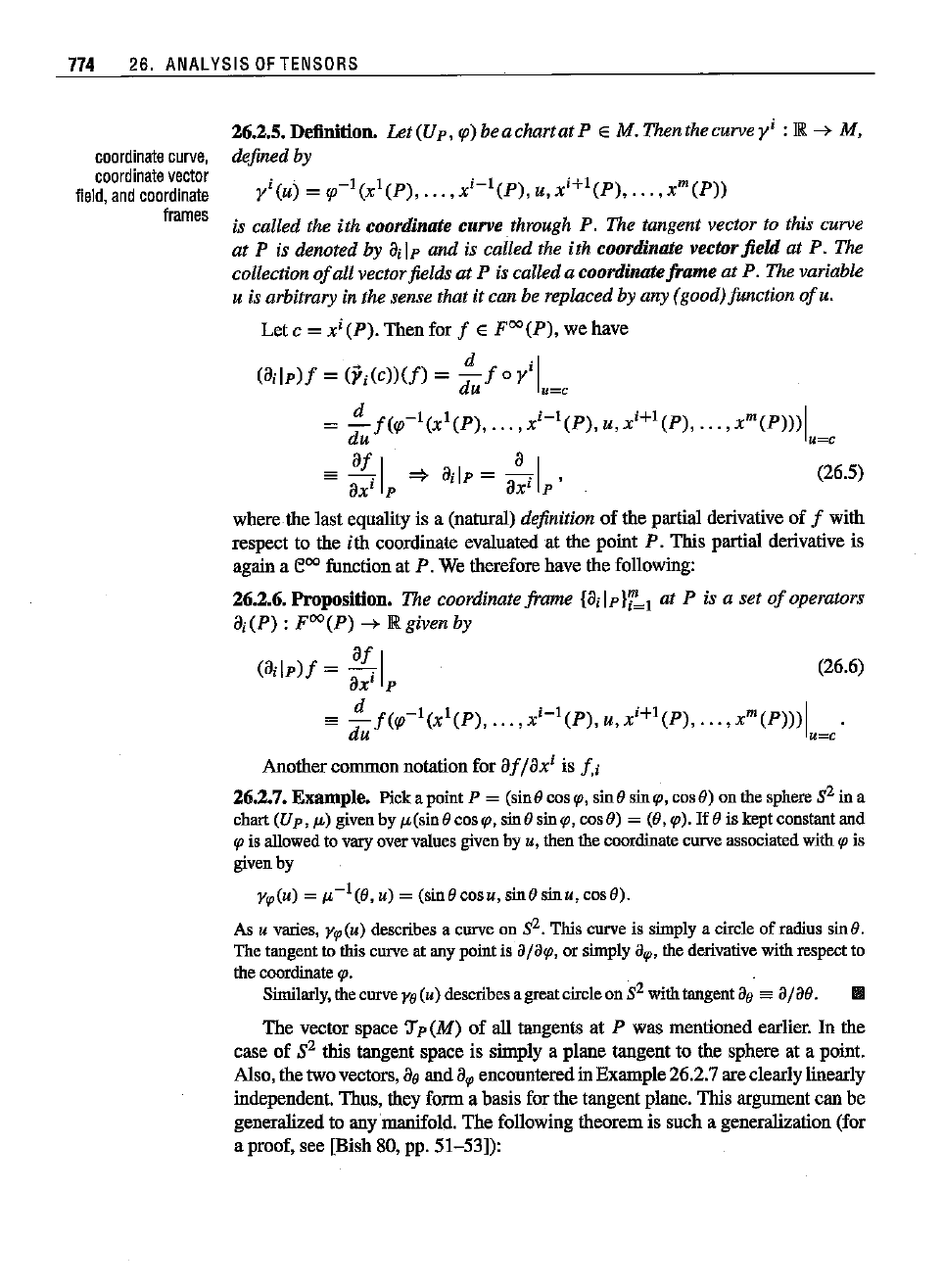
774
26.
ANALYSIS
OF
TENSORS
coordinate
curve,
coordinate
vector
field,
and
coordinate
frames
26.2.5.Definition. Let (Up, rp)beachartatP
EM.
Thenthe curve y' :
lR
-+ M,
defined by
yi (u) = rp-I(xl (P),
...
,
xi-I(p),
u,
xi+l(p),
...
,
xm(P))
is called the ith coordinate curve through P. The tangent vector to this curve
at P is denoted by aiIp and is called the ith coordinate vectorfield at P. The
collection
of
all vectorfields at P iscalled a coordinateframe at P. The variable
u is arbitrary inthe sense that it can be replaced by any (good)junction
of
u.
Let c = xi (P). Then for f E F""(P), we have
• d il
(ailp)f
=
(Yi(C»(f)
=
dJ
0 y u=c
=
.!:.-
f(rp-I(xl(p),
...
,xi-l(p),
u,xi+l(p),
...
,xm(pml
du u=c
==
::i
I
p
=}
ailp =
a~i
Ip
, (26.5)
wherethe last equalityis a (natural)
definition of the partial derivative of f with
respect to the ith coordinateevaluatedat the point
P. This partial derivative is
againa
e""
functionat P. Wethereforehavethe following:
26.2.6.Proposition.
The coordinateframe (aiIp
Ir=1
at P is a set
of
operators
ai(P) : F""(P) -+
lR
given by
(ailp)f=
afl
(26.6)
ax'
p
==
dd
f(rp-I(xl(p),
...
,
xi-l(p),
u,
xi+l(p),
...
,
xm(p»)1
.
U
u=c
Anotherconunonnotationfor
af/ax
i
is f.i
26.2.7.Example.
Pick
a
point
p =
(sinB
cosrp,
sinB
sinrp,
cosB)onthe
sphere
S2ina
chart
(Up, 1")
given
hy
I"(sin
Bcosip, sinBsinip, cosB) = (B,
rp).1f
Bis
kept
constant
and
qJ
is allowedtovaryovervaluesgivenby u, thenthe
coordinate
curveassociated with
q;
is
given
by
y~(u)
= I"-I(B,u) =
(sinB
cosu,
sinB
sinu, cosB).
As u
varies,
ytp
(u)
describes
a curveon S2. Thiscurveis simplya circle of
radius
sine.
The
tangent
to this
curve
atanypointis
fJ/ocp,
orsimply
arp,
the
derivative
with
respect
to
the
coordinate
ip,
Similarly,
the
corve
Ye
(u)
describes
a
great
circle
onS2
with
tangent
ae
ee
a/
aB.
III
The vector space Tp
(M)
of all tangents at P was mentioned earlier. In the
case of 8
2
this tangent space is simply a plane tangent to the sphere at a point.
Also,thetwovectors,
aeand
a~
enconnteredinExample26.2.7areclearlylinearly
independent.Thus,theyform a basisforthe tangentplane.This argumentcan be
generalizedto anymanifold.The following theoremis such a generalization(for
a proof,see [Hish80,pp. 51-53]):
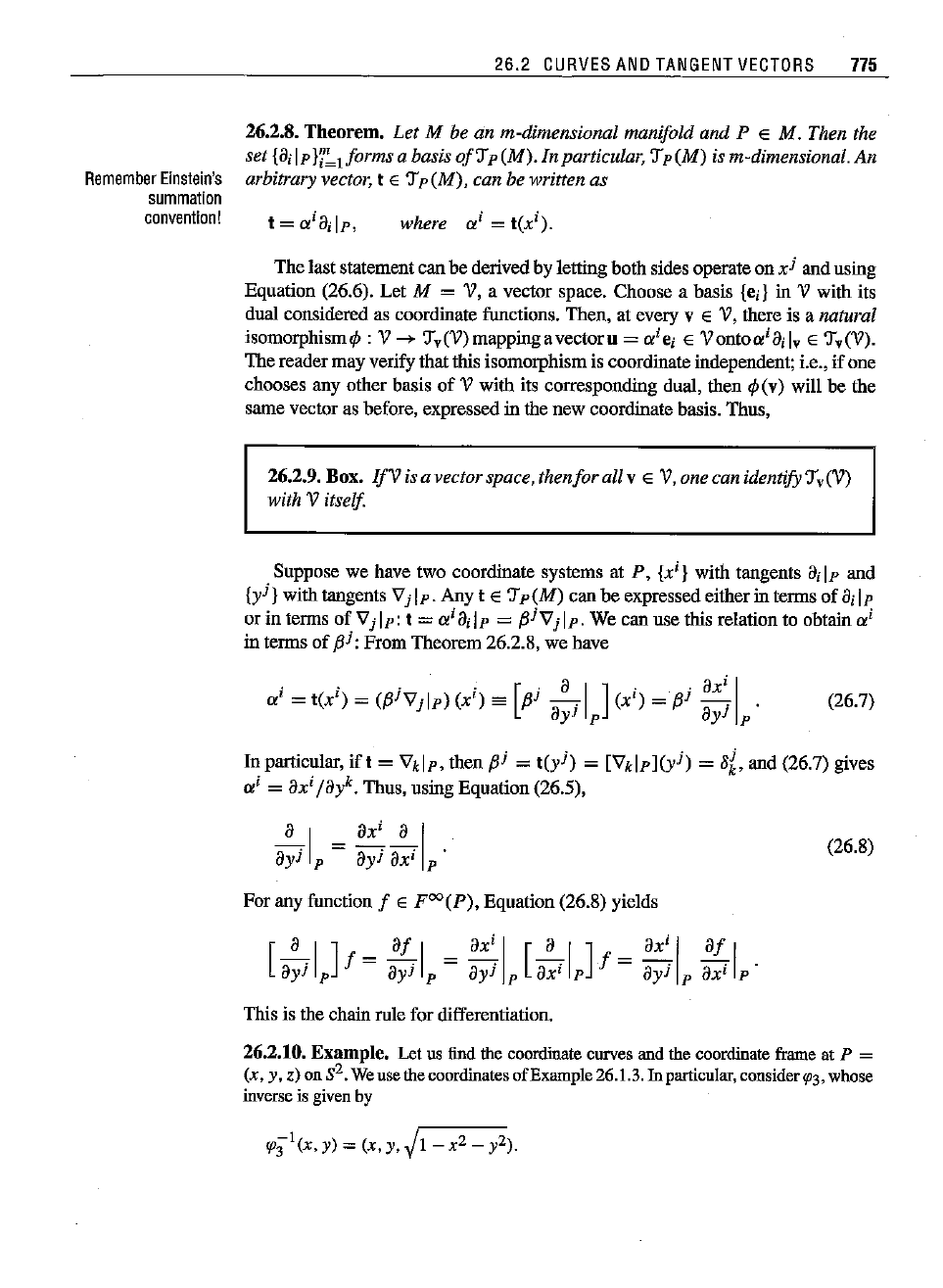
(26.7)
Remember
Einstein's
summation
convention!
26.2
CURVES
AND
TANGENT
VECTORS
775
26.2.8.
Theorem.
Let M be an m-dimensional manifold and P E M. Then the
set {aiIp}7::dorms a basis oj'J'
p(M).
In particular, 'J'p(M) is m-dimensional. An
arbitrary vector,
I E 'J'p(M), can be written as
Thelast statement can be derived by letting both sides operate on
xi
and usiog
Equation (26.6). Let
M = V, a vector space. Choose a basis {e.} io V with its
dual
considered as
coordinate
functions.
Then,ateveryv E V,
there
is a natural
isomorphisme :V --> 'J'v(V)mappiogavectoru = aiei E
Vontoaiailv
E 'J'v(V).
The readermay verify that this isomorphism is coordioate iodependent; i.e.,
if
one
chooses any other basis
of
V with its corresponding dual, then .p(v) will be the
samevectoras before,expressedinthenew coordinate basis.Thus,
26.2.9. Box.
IjV
isa vector space, thenjorall v E V,one can identify
'J'v
(V)
with Vitself.
Suppose we have two coordinate systems at P, {xi} with tangents ailp and
{yi} with tangents
Vi
Ip. Any
IE
'J'
p(M)
can be expressed either io terms of ailp
or in terms of
Vi
Ip: I = a
i
ailp =
pi
Vi
Ip. We can use this relation to obtaio a
i
in terms of
pi:
From Theorem 26.2.8, we have
a
i
=I(x
i)
=
(piVilp}(xi)
==
[pi
~I
](xi)
=pi
aXi.J
.
ay} p ay} p
In particular,
if
t =
Vklp,
then
pi
=
I(yi)
= [Vklp](yi) =
81,
and (26.7) gives
a
i
= ax
i
/a/.
Thus, usiog Equation (26.5),
(26.8)
For any function j E FOO(P),Equation (26.8) yields
This is the chaio rule for differentiation.
26.2.10.
Example.
Let us find the coordinate curves and the coordinate frame at P =
(x, y, z) on S2. Weusethe
coordinates
ofExample26.1.3.In
particular,
consider
({J3.
whose
inverse
is givenby
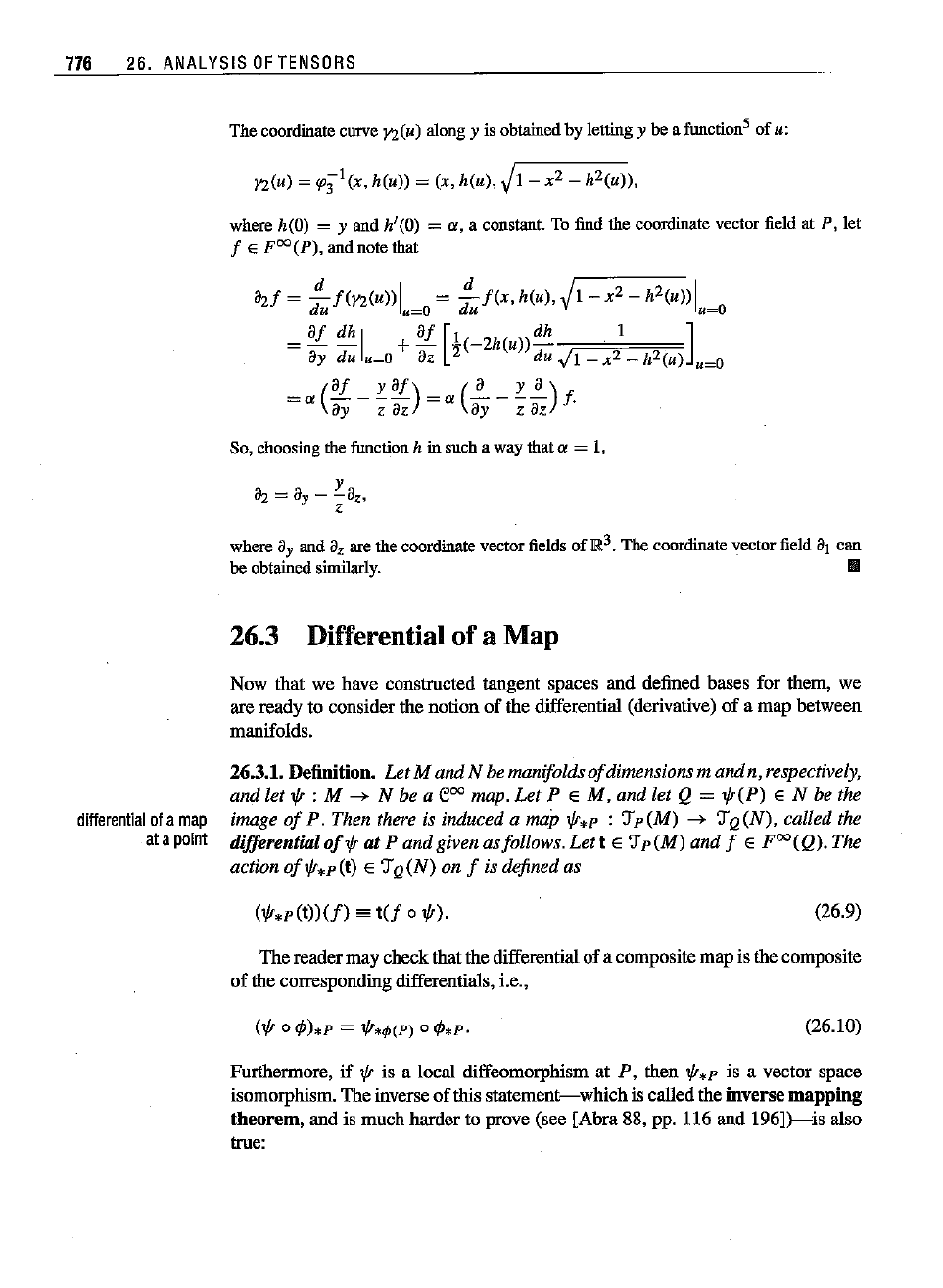
776 26. ANALYSIS
OF
TENSORS
Thecoordinate corvey.!(u) alongy is obtainedby letting y be afunction
5
of u:
where h(O) = y and h'(O) = a, a constant.To find the coordinatevector field at P, let
f E
FOO(P),
andnotethat
azf
=
.'!...-
f(Y.!(u)) I =
.'!...-
f(x,
h(u),
JI-
x
2
- h
2(u))
I
du
u=o
du
u=O
af
dh I
af
[1
dh 1 ]
= - - +-
-(-2h(u))
ay du u=o az 2 du
,}I-
x
2
- h
2(u)
u=o
=a(a
f
_?'.-af)=a(~_?'.-~)f.
ay z az ay z az
So, choosing the function h in such a way that a = 1,
y
az
=ay- -ar,
z
where a
y
and
a
z
are the coordinate vector fields of IR
3.
The coordinate vector field
al
can
be
obtainadsimilarly. ill
26.3 Differential of a Map
Now that we have constructed tangent spaces and defined bases for them, we
are ready to consider the notion
of
the differential (derivative)
of
a map between
manifolds.
differential
ofa
map
ata
point
26.3.1. Definition.
Let
M
and
N be manifolds
of
dimensionsm
and
n, respectively,
and
let
1ft
: M --> N be a e
oo
TYUlp.
Let
P E
M,
and
let Q = 1ft(P) E N be the
image
of
P. Then there is induced a
map
1ft,P :
'Jp(M)
-->
'JQ(N),
called the
differentialof1ft
at
P
and
given
asfollows.
Let
IE
'J
p(M)
and
f E FOO(Q). The
action
of1ft,p(l)
E 'J
Q(N)
on f is defined as
(1ft,p(I»(f)
==
l(f
0 1ft). (26.9)
The
readermay checkthat the differential
of
a compositemap is the composite
of
the corresponding differentials, i.e.,
(1ft
0
</J),p
= 1ft,¢(P)0
</J,p.
(26.10)
Furthermore, if
1ft
is a local diffeomorphism at
P,
theu
1ft
,p
is a vector space
isomorphism. The inverse
of
this
statement-which
is called the
inverse
mapping
theorem,
and is much harder to prove (see [Abra 88, pp. 116 and 196]}--is also
true:

inverse
mapping
theorem
26.3
DIFFERENTIAL
DF
A
MAP
777
26.3.2.
Theorem.
(inverse mapping theorem)
If
1ft
: M
--+
N is a map
and
1ftoP
:
'Jp(M)
--+
'Jy,(p)(N) is a vector space isomorphism, then
1ft
is a local
dijfeomOlphism at P.
Letus seehowEquation(26.9)looksintemnsofcoordinatefunctions.Suppose
that {xili'=l are coordinatesat P and
{yal:=l
are coordinatesat Q = 1ft(P). We
notethat
ya o
1ft
is areal-valuede
oo
functionon M. Thus,wemay write(withthe
functionexpressedin
temns
of coordinates)
Wealso have
1=
a
i
ailp. Similarly,1ftop(l) = tJa(a/aya)IQ because {a/aya)IQl
fomn
a basis.Theorem26.2.8and Definition26.3.I now give
tJa = 1ftop(I)(ya) = I(ya 0
1ft)
=
l(fa)
at"
m
at"
=[aiailp](t")=ai-.I
="'ai_·I·
ax'
p
L.,
ax'
p
1=1
Thiscan be writtenin matrix
fomn
as
(
tJ
l
)
(afl/aXI
tJ2
af2/ax
l
· .
· .
· .
tJn
af"/ax
l
afl/aX
m)
(a
l)
af2/ax
m
a
2
·
.'
· .
· .
afn/ax
m
am
(26.
II)
Jacobian
matrix
of
of
a
differentiable
map
Differential
a
constant
map
is
the
zero
map.
The n x m matrix is denoted
by
J and is called the
Jacobian
matrixof
1ft
with
respect to the coordinates
xi
and ya. On numerous occasions the two manifolds
are simplyCartesianspaces,so that
1ft
:
~m
--+
R",
In
sucha case,
f"
is naturally
writtenas 1ft",and the Jacobianmatrix will haveelementsof the
fomn
a1ft"
/ax
i.
An important special case of the differential of a map is that of a constant
map.Let
1ft
: M
--+
{Ql E N be such a map;it maps allpoints of M onto a single
point
Q of
N.
For any f E Foo(Q), the function f 0
1ft
E
FOO(P)
is constantfor
all P
EM.
Let I E 'Jp
(M)
be an arbitraryvector.Then
(1ftop(I))(f) es
l(f
0
1ft)
= 0
(26.12)
because
I(c) = 0 for any constantc. So,
26.3.3.Box.
If
1ft
: M
--+
{Q
lEN
is a constant map, so that it maps the
entire manifold M onto a
point
Q
of
N,
then
1ftoP
:
'Jp(M)
--+
'J
Q(N)
is
the zero map,
SSeethelast
statement
of Definition 26.2.5.
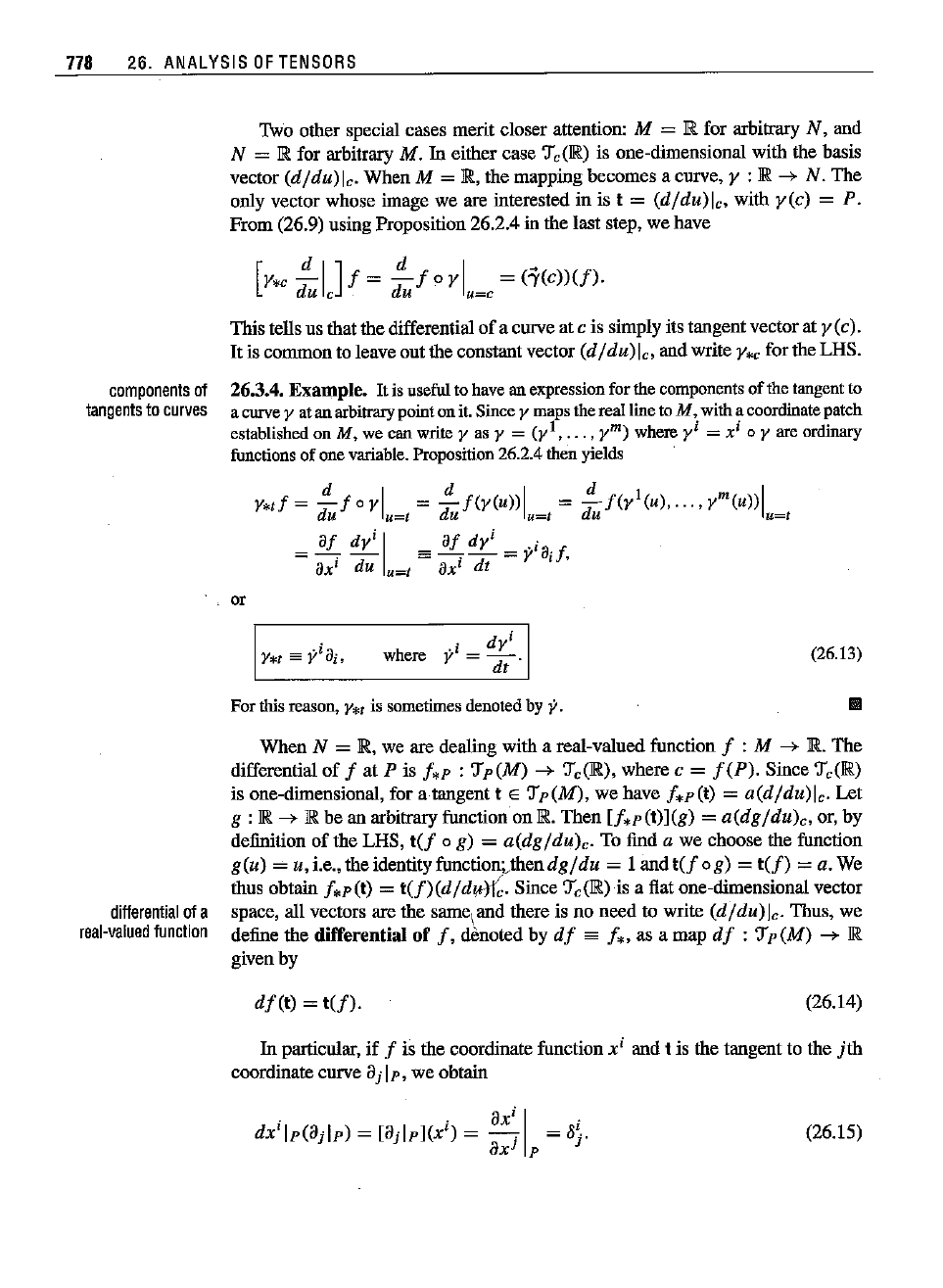
778 26.
ANALYSIS
OF
TENSORS
1\\'0 other special cases merit closer attention: M =
JR
for arbitrary N, and
N =
JR
for arbitrary M. In either case 'J,(JR)is one-dimensional with the basis
vector
(dldu)
I,.When M =
JR,
the mapping becomes a curve, y :
JR
-->
N. The
only vector whose image we are interested in is
1=
(dldu)I" with
y(c)
= P.
From (26.9) using Proposition 26.2.4 in the last step, we have
[
yo,
dd
I] f =
dd
f 0 y I =
(f(c»(f).
U c U u=c
This tells us that the differential
of
a curve at c is simply its tangent vector at y (c).
It
is commonto leave out the constant vector
(dldu)
I" and write y*, for the LHS.
components
of
tangenfs
to
curves
26.3.4. Example. Itis usefultohavean
expression
forthe
components
ofthe
tangent
to
acurvey atan
arbitrary
pointonit.Since y mapsthereal line to
M.
witha
coordinate
patch
established
on
M.
we can
write
y as y =
(yl,
...
, ym)
where
r' = xi 0 yare
ordinary
functions
ofone
variable.
Proposition
26.2.4
then
yields
did
I d
j
ml
y*t!
= - f 0 y = -
f(y(u))
= -
f(y
(u),
...
, y (u»
du u=1 du u=t du u=t
= af
dyi
I es af
dyi
=
·yiad,
ax' du
u=1
ax' dt
or
(26.13)
Forthis
reason,
Y*t
is
sometimes
denoted
by y.
When N =
JR,
we are dealing with a real-valued function f :M
-->
R The
differential of
fat
P is fop :
'Jp(M)
-->
'J,(IR), where c =
f(P).
Since 'J,(JR)
is one-dimensional, for a tangent
IE
'Jp(M),
we have f*p(l) =
a(dldu)I,.
Let
g :
JR
-->
JR
be an arbitrary function on R Then [f*p(l)](g) =
a(dgldu)"
or, by
definition of the LHS,
l(f
0 g) =
a(dgldu),.
To find a we choose the function
g(u) =u,i.e.,theidentityfunctionjthen zigyds =I
andl(f
og)
=
l(f)
=a. We
thus obtain
f.p(t)
=
l(f)(dldwlk.
Since 'J,(JR)is a flat one-dimensional vector
differentialofa
space, all vectors are the same.and there is no need to write
(dldu)I,.
Thus, we
real-valued
function
define the differential of
f,
denoted by
df
sa
f.,
as a map
df
:
'Jp(M)
-->
JR
given by
df(l)
=
l(f).
(26.14)
In particnlar, if f is the coordinate function
xi
and I is the tangent to the
jth
coordinate curve aj I
p,
we obtain
(26.15)

Remember
Einstein's
summation
convention!
26.3
DIFFERENTIAL
DF
A
MAP
779
This shows that
26.3.5. Box.
{dx'
[p
}?::I
is dual to the basis
{ajlp
}j=1
of'J
p(M).
26.3.6.
Example.
Letf:
M -+
Rbe
areal-valuedfunctionnnM. Letxi becnnrdinates
atP. We
want
to
express
df
in
terms
of
coordinate
functions.
Fort E 'Jp (M) wecanwrite
t =a
i
ailp
and
df(t)
=
t(f)
= ar'[8;1p
](f)
=
,,!a,(f),
wberein the last step,we suppressed the P. Theorem26.2.8and Equation(26.14)yield
ee'
=
t(x')
= (dx')(t). Wethusbave
df(t)
=
8,(f)[(dx')(t)]
=
[8i(f)(dx
i)](t).
Sincethisis
true
forallt, we get
.
~
.
~8f
.
df
=
8,(f)(dx')
sa
L..
8
,(
f)
(dx' ) =
L..
-,dx'.
i=l
i=l
ax
(26.16)
Thisis theclassical
formula
forthe
differential
of a
function
f.
If
we chooses', the
jth
member
of anew
coordinate
system,
forf. we
obtain
whichisthe transformation dualto Eqnation(26.8).
(26.17)
III
The
following is a powerful theorem that constructs a submanifold out
of
a
differeutiable map (for a proof, see [Warn 83, p. 31]):
26.3.7.
Theorem.
Assume
than?
: M
-+
N is a
e""
map, that Q is a
point
in the
range
of
1/J,
and
that
1/J.
:
'Jp(M)
--'> 'J
Q(N)
is surjective
for
all P E 1/J-I(Q).
Then 1/J-I(Q) is a submanifold
of
M
and
dim 1/J-I(Q) =
dimM
-
dimN.
Compare this theorem with Propositiou26.1.10. There, V was an open subset
of
N,
and since
r:'
(V)
is open, it is automatically an open submanifold.
The
difficulty in proving Theorem26.3.7 lies in the fact that
1/J
-I
(Q)
is closed because
{Q}, a single point
of
N, is closed.
We can justify the last statement
of
the theorem as follows. From Equation
(26.12), we readily conclude that 'Jp (1/J-I
(Q))
= ker 1/J.p.The dimension theo-
rem, applied to
1/J.P
:
'Jp(M)
--'>'J
Q(N),
now gives
dim
'Jp(M)
=dimker1/J.p +rank1/J.p
=}
dimM
= dim 1/J-I(Q)
-+-
dimN,
where the last equality follows from the surjectivity
of
1/J.p.
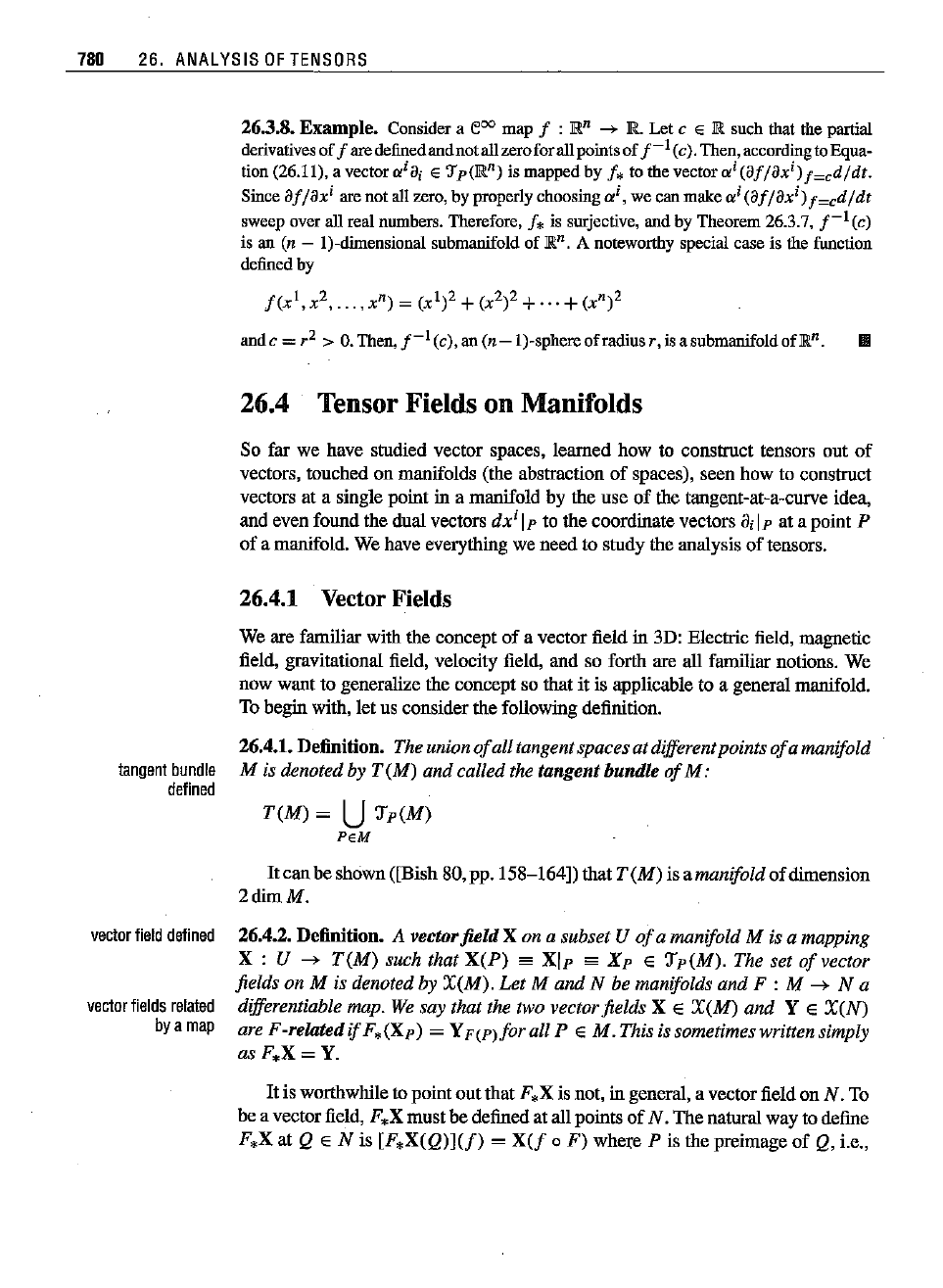
780
26. ANALYSIS
OF
TENSORS
26.3.8.Example. Consider a e
oo
map / : R" -+
lEI.
Let c E
lEI
snch that the partial
derivatives
of/ are
defined
andnotallzeroforall pointsof
/-1
(c).Then,
according
toEqna-
tion(26.11), a vector
cia, E
Tp(lEI
n
)
is mappedhy
/.
to thevector
(Jl'
(aJ/ax')
f=cd/dt.
Sinceai/ax' arenot allzero,hyproperly choosing
(Jl',
wecanmake
(Jl'
(a//ax')
f=cd/dt
sweepoverall
real
numbers.
Therefore,
f* is
surjective,
andby
Theorem
26.3.7,
j-ICc)
is an (n - I)-dimensional
submanifold
of R". A
noteworthy
specialcase is the
function
defined
by
/(x!, x
2
,
...
, x
n
)
= (x
l
)2
+(x
2
)2
+...+(x
n
)2
andc = r
2
>
O.
Then,/-I
(c),an(n-I)-sphereofradinsr, isasubmanifold ofR".
III
26.4 TensorFields on Manifolds
So far we have studied vector spaces, learned how to construct tensors ont
of
vectors, tonched on manifolds (the abstraction of spaces), seen how to construct
vectors at a single point in a manifold by the use
of
the tangent-at-a-curve idea,
and even found the dual vectors
dx'
Ip to the coordinate vectors 8,Ip at a point P
of a martifold. We have everything we need to study the analysis of tensors.
26.4.1
Vector
Fields
We are familiar with the concept of a vector field in 3D: Electric field, magnetic
field, gravitational field, velocity field, and so forth are all familiar notions. We
now want to generalize the concept so that it is applicable to a general martifold.
To begin with, let us consider the following definition.
26.4.1.Definition. The union
of
all tangent spaces atdifferentpoints0/a manifold
tangent
bundle
M is denoted by
T(M)
and called the tangent bundle
of
M:
defined
T(M)
= U
'Jp(M)
PeM
It
can be shown ([Bish 80, pp. 158-164])that T
(M)
is amanifold
of
dimension
2dimM.
vector
field
defined
vector
fields
related
bya
map
26.4.2.Definition. A vectorfield X on a subset U
of
a manifold M is a mapping
X : U
-+
T(M)
such that
X(P)
es
Xlp
sa
X»
E 'Jp(M). The set
of
vector
fields on M is denoted by X(M).
Let
M and N be manifolds and F : M
-+
N a
differentiable map. We say that the two vector fields
X E
X(M)
and Y E
X(N)
are F-related
if
F.(X
p)
= YF(p)/orall P
EM.
This is sometimes written simply
as
F.X
= Y.
It
is worthwhile to point
out
that
F.X
is not, in general, a vector field on N. To
be a vector field,
F.X
mnst be defined at all points
of
N. The natural way to define
F.X
at Q E N is
[F.X(Q)](f)
=
X(f
0 F) where P is the preimage
of
Q,i.e.,
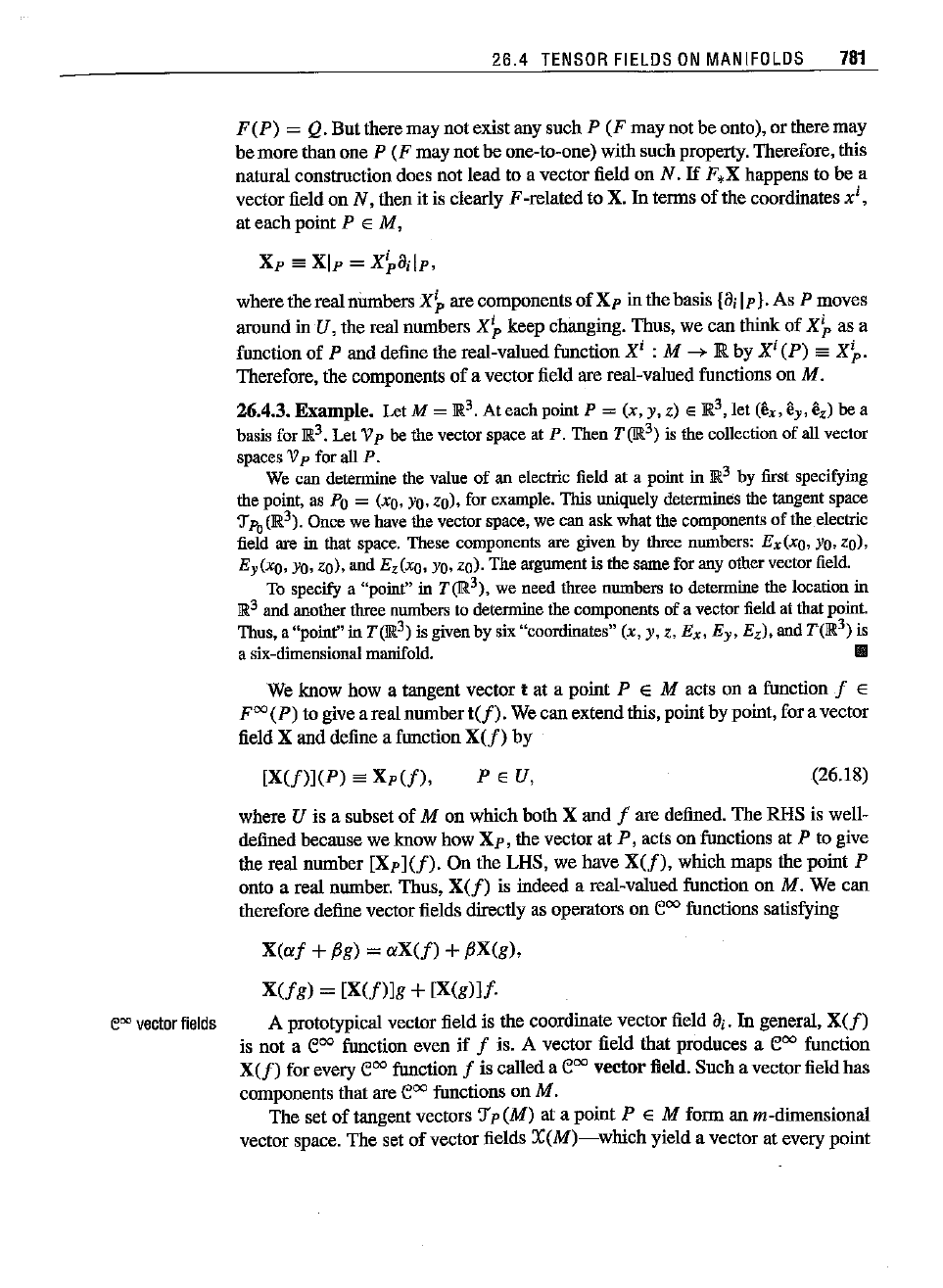
26.4
TENSOR
FIELDS
ON
MANIFOLDS
781
F(P)
= Q.But there may not existany such P
(F
may not be onto), or there may
be more than one
P (F may not be one-to-one) with such property. Therefore, this
natural construction does not lead to a vector field on N.
If
F.X
happens to be a
vector field on N, then it is clearly F-related to X. In terms of the coordinates
xi,
at each point P E
M,
X
p
'"
Xlp
=
X~Bilp,
where the real numbers
X~
are components
of
X» in the basis {Bilp
[.As
P moves
around in
U,
the real numbers
X~
keep chimging. Thus, we can think of
X~
as a
function of P and define the real-valued function Xi : M
--+
R by Xi
(P)
ea
X~.
Therefore, the components
of
a vector field are real-valued functions on M.
26.4.3.
Example. Let M = ]R3. At eachpoint P = (x, y, z) E ]R3, let (ex, ey, e
z
) be a
basis for
}R3.
Let
Vp bethe vector space at
P.
Then
TOR
3
)
is
the
collection
of
all vector
spacesVp for all P.
We can determine the value of an electric field at a point in
JR3
by first specifying
thepoint,as Po = (xo,
YO,
zo), for
example.
Thisuniquely determines the tangentspace
'JPo(lR.
3
). Once we have the vector space, we can
ask
what
the components
of
the electric
field are
in that space. These components are given by three numbers: Ex(xQ.
YO,
ZO),
Ey(xO,
YO,
zo), andEz(xo,
YO,
ZO)·
Theargoment is thesameforanyothervector
field.
To specify a "point" in
TOR
3
) ,
we need three numbers to determine the location in
}R3
and
another three numbers to determine the components of a vector field at that point.
Thus, a "point"
in TOR
3
)
is givenby six "coordinates" (x, y, z,
Ex.
E
y,
E
z),
and
T(}R3) is
a six-dimensionalmanifold.
III
We know how a tangent vector t at a point P E M acts on a function f E
FOO(P) to give
areal
numbert(f).
Wecan extendthis, point by point, for a vector
field X and define a function
X(f)
by
[X(f)](P)
'"
Xp(f),
P E U,
(26.18)
where U is a subset
of
M on which both X and f are defined. The RHS is well-
defined because we know how
Xp,
the vector at P, acts on functions at P to give
the real number [Xp
](f).
On the LHS, we have
X(f),
which maps the point P
onto a real number. Thus,
X(f)
is indeed a real-valued function on M. We can
therefore define vector fields directly as operators on
e
oo
functions satisfying
X(otf
+fJg) =
otX(f)
+fJX(g),
X(fg)
=
[X(f)]g
+
[X(g)]f.
e
oo
vector
fields
A prototypical vector field is the coordinate vector field B
i
•
In
general,
X(f)
is not a e
oo
function even if f is. A vector field that produces a e
oo
function
X(f)
for every e
oo
function f is called a e
oo
vector field. Such a vector field has
components that are e
oo
functions on M.
The set of tangent vectors 'Jp
(M)
at a point P E M form an m-dimensional
vector space. The set of vector fields
X(M)-which
yield a vector at every point

782
26.
ANALYSIS
OF
TENSORS
of the
manifold-also
constitutes a vector space. However, this vectur space is
(uncountably) infinite-dimensional. A property
of
X(M)
that is absent in
'J
p (M)
is composition." This suggests the possibility
of
defining a "product" ou
X(M)
to
tum
it into an algebra. Let X and Y be vector fields. For X 0 Y to be a vector field,
it has to satisfy the derivatiou property. But
x 0
Y(fg)
=
X(Y(fg))
=
X(Y(f)g
+
fY(g))
=
(X(Y(f)))g
+
Y(f)X(g)
+
X(f)Y(g)
+
f(X(Y(g)))
'I
(X 0
Y(f))g
+
f(X
0
Y(g)).
However, the reader may verify that Xo Y- Y
oX
does iudeedsatisfy the derivatiou
The
setof
vector
property. Therefore, by defining the binary operation X(M) x X(M) --> X(M) as
fields
form
a
Lie
algebra.
[X, Y]
==
X 0 Y - Y 0 X,
X(M)
becomes an algebra, called the
Lie
algebra
of vector fields of M. The
binary operation is called the
Lie
bracket.
Although it was not mentioned at the
time, we have encountered another example
of
a Lie algebra in Chapter 2, namely
£,(V) under the binary operation
of
the commutation relation. Lie brackets have
the following two properties:
[X,
Y]
=
-[V,
X],
[[X, V], Z] +[[Z, X], Y] +[[Y, Z], X] =
O.
These two relations are the defining properties
of
all Lie algebras. The last re-
Jacobi
identity
lation is called the
Jacobi
identity.
X(M)
with Lie brackets is an example of
an infinite-dimensional Lie algebra;
£,(V) with commutators is an example of a
finite-dimensional Lie algebra.
We shall have occasion to use the following theorem in our treatment of Lie
groups and algebras in the next chapter:
26.4.4.
Theorem.
Let M and N be manifolds and F : M
-->
N a differentiable
map. Assume that Xi E
X(M)
is F-related to Yi E
X(N)
for i = 1,2. Then
[XI, X2] is F-relatedto [YI, Y2], i.e.,
F.[XI,
X2] =
[F.XI,
F.X2].
Proof. Let f be an arbitrary fuoction on N. Then
(F.
[XI, X2]) f es
[Xl,
X2](f
0 F) = XI
(X2(f
0
F))
- X2
(XI(f
0
F))
= XI
([F.X2(f)]
0 F) - X2
([F.XI(f)]
0 F)
=
F.XI
(F.X2(f))
-
F.X2
(F.XI
(f))
=
[F.X
I, F.X2]f,
6Recall that a typical element
ofT
p(M)
is a map t : FOO(P)
--+-
R for which composition is meaningless.
